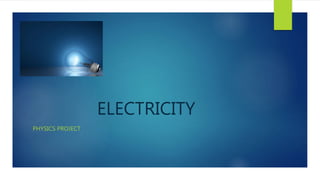
Electricity
- 2. WHAT IS ELECTRICITY??? Electricity is the set of physical phenomena associated with the presence and flow of electric charge. Electricity gives a wide variety of well-known effects, such as lightning, static electricity, electromagnetic induction and electrical current. In addition, electricity permits the creation and reception of electromagnetic radiation such as radio waves.
- 3. WHAT IS ELECTRIC CHARGE??? electric charge: a property of some subatomic particles, which determines their electromagnetic interactions. Electrically charged matter is influenced by, and produces, electromagnetic fields. electric field : an especially simple type of electromagnetic field produced by an electric charge even when it is not moving (i.e., there is no electric current). The electric field produces a force on other charges in its vicinity. electric current: a movement or flow of electrically charged particles, typically measured in amperes. electromagnets: Moving charges produce a magnetic field. Electrical currents generate magnetic fields, and changing magnetic fields generate electrical currents.
- 4. ELECTROSTATIC INDUCTION Electrostatic induction is a redistribution of electrical charge in an object, caused by the influence of nearby charges.[1] In the presence of a charged body, an insulated conductor develops a positive charge on one end and a negative charge on the other end.[1] Induction was discovered by British scientist John Canton in 1753 and Swedish professor Johan Carl Wilcke in 1762. Electrostatic generators, such as the Wimshurst machine, the Van de Graaff generator and the electrophorus, use this principle. Due to induction, the electrostatic potential (voltage) is constant at any point throughout a conductor. Induction is also responsible for the attraction of light nonconductive objects, such as balloons, paper or styrofoam scraps, to static electric charges. Electrostatic induction should not be confused with electromagnetic induction.
- 6. CURRENT CHARGE AND CURRENT CHARGE =CURRENT X TIME Q) WHAT CHARGE IS DELIVERED IF A) A CURRENT OF 10A FLOWS FOR 5 SECONDS A CURRENT OF 250MA FLOWS FOR 40 SECONDS
- 7. RESISTANCE Electrical resistance, a measure of the degree to which conductor opposes an electric current through that conductor. RESISTANCE FORMULA : PD/CURRENT THROUGH CONDUCTOR FACTORS AFECTING RESISTANCE : LENGTH Cross sectional area Material temperature
- 8. ohm’s law Ohm's law states that the current through a conductor between two points is directly proportional to the potential difference across the two points. Introducing the constant of proportionality, the resistance, one arrives at the usual mathematical equation that describes this relationship: I = v/r where I is the current through the conductor in units of amperes, V is the potential difference measured across the conductor in units of volts, and R is the resistance of the conductor in units of ohms. More specifically, Ohm's law states that the R in this relation is constant, independent of the current.
- 9. Circuit analysis In circuit analysis, three equivalent expressions of Ohm's law are used interchangeably: I = v/r quad text{or}quad V = IR quad text{or} quad R = v/i Each equation is quoted by some sources as the defining relationship of Ohm's law, or all three are quoted, or derived from a proportional form,[23] or even just the two that do not correspond to Ohm's original statement may sometimes be given The interchangeability of the equation may be represented by a triangle, where V (voltage) is placed on the top section, the I (current) is placed to the left section, and the R (resistance) is placed to the right. The line that divides the left and right sections indicate multiplication, and the divider between the top and bottom sections indicates division (hence the division bar).
- 10. Ohm’s law
- 11. Resistance in series and parallel
- 12. power In physics, power is the rate of doing work. It is equivalent to an amount of energy consumed per unit time. In the MKS system, the unit of power is the joule per second (J/s), known as the watt in honor of James Watt, the eighteenth-century developer of the steam engine. The integral of power over time defines the work performed. Because this integral depends on the trajectory of the point of application of the force and torque, this calculation of work is said to be path dependent. The same amount of work is done when carrying a load up a flight of stairs whether the person carrying it walks or runs, but more power is needed for running because the work is done in a shorter amount of time. The output power of an electric motor is the product of the torque that the motor generates and the angular velocity of its output shaft.
- 13. Power equations
- 14. energy Energy transformation; In a typical lightning strike, 500 mega joules of electric potential energy is converted into the same amount of energy in other forms, most notably light energy, sound energy and thermal energy. In physics, energy is a property of objects, transferable among them via fundamental interactions, which can be converted into different forms but not created or destroyed. The joule is the SI unit of energy, based on the amount transferred to an object by the mechanical work of moving it 1 meter against a force of 1 newton. Work and heat are two categories of processes or mechanisms that can transfer a given amount of energy. The second law of thermodynamics limits the amount of work that can be performed by energy that is obtained via a heating process—some energy is always lost as waste heat. The maximum amount that can go into work is called the available energy. Systems such as machines and living things often require available energy, not just any energy. Mechanical and other forms of energy can be transformed in the other direction into thermal energy without such limitations.
- 15. Done by: Dalia osama 10 a